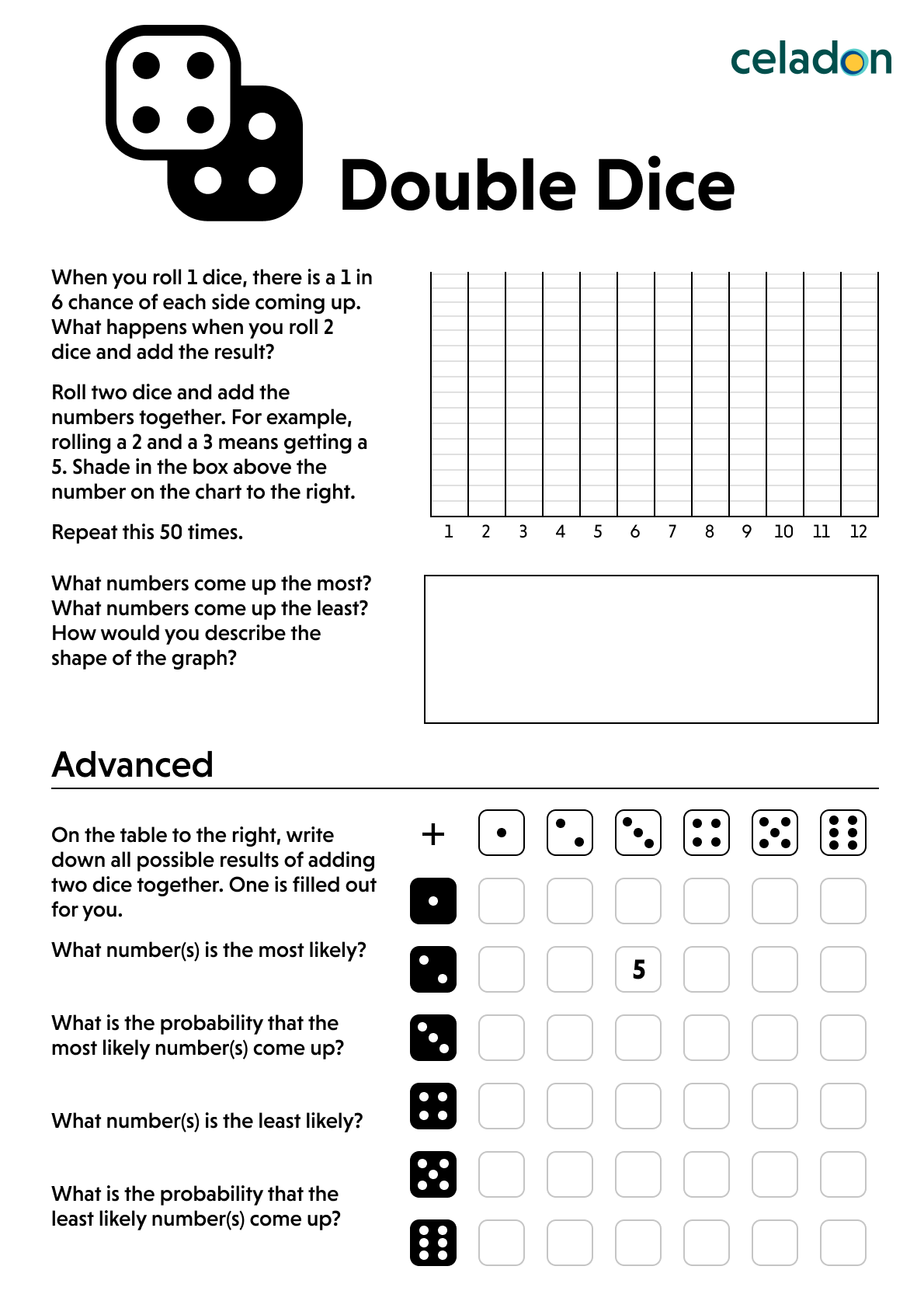Probability is one of our favourite mathematics concepts! Despite it being everywhere in the world around us, it can be hard to come up with interesting math problems.
Lessons around probability often start with dice rolling and coin flips. Dice rolling is great because it’s usually in a child’s life through board games. Lots of board games don’t have one dice, they have two!
This adds a little complexity to the problem. When we roll two dice and add the result, we can ask a bunch of questions, like:
- What are all the different numbers that can come up?
- What are the most common number(s)?
- What is the chance of the most common number(s) coming up?
- What are the least common number(s)?
- What is the chance of the least common number(s) coming up?
We’ve put together a printable worksheet that your child can work through on their own or with you. This post also has a detailed explanation on the problems in the worksheet. Click to download.
Problem 1: Performing an experiment
This is great for children who are just getting started with probability. It’s just about observation!
Break out a piece of paper and draw an x (horizontal) axis for a graph on it. On the axis write 1, 2, 3... all the way up to 12.
Then you and your child can roll two dice, add up the numbers, and record each sum. If you’re on paper with squares, you can colour in a square for each roll.
Do this for a while, it’ll take some time (around 50 rolls) before you see noticeable patterns. You could even do it over multiple days for 5 minutes a day.
After this is done, you may have something that looks like this:
We can’t make any guarantees as we’re dealing with randomness—that’s the whole point of probability and statistics. However, the trend should emerge that there are fewer rolls on the lowest and higher numbers, with a bump in the middle (around 6-8).
Here’s the interesting result: not all numbers have the same probability! Unlike rolling a single die, where each number has the same chance of coming up, rolling two die makes the distribution of results uneven. If you’re trying to make up your own dice games, this becomes important to keep in mind.
Problem 2. Working out the probabilities
In the experiment we determined that the numbers around the middle are the most likely. For more advanced children who understand probability as numbers (e.g. a coin flip has a 1 in 2 chance of coming up tails), we can work this out more precisely. According to probability theory, which is the most common number? Is there more than one of them?
We can work this out by calculating every single outcome of rolling two die. There are only 36 of them. Using a chart like this, we can calculate all of them. Here they are
Immediately we can see some patterns emerge. There are these diagonal strips of numbers going from the bottom left to the top right. I think you can see what the most common number is now. We can look at it a slightly different way, though, by putting it into the histogram from above.
What do you observe here? Here are some things we see:
- The shape is much neater than the experiment from before. In fact, it’s a perfect triangle!
- 7 is the most common result. How do we work out the probability of getting a 7? Well, we divide the number of times it comes up (6 times) by all the possible outcomes(36). So it’s a 6 in 36 chance. Or a 1 in 6 chance.
- 2 and 12 are the least common results. They each have a 1 in 36 chance of appearing.
- 1 is impossible to come up
That’s just the way the dice roll
This is a fun exercise in probability that’s a little more complex than the single dice roll. You can take it further, too. What do you think would happen with three dice? What happens when you multiply the numbers instead of adding them?
We’d love to hear about how you use this exercise, so let us know on email, Twitter, Facebook or Instagram.






